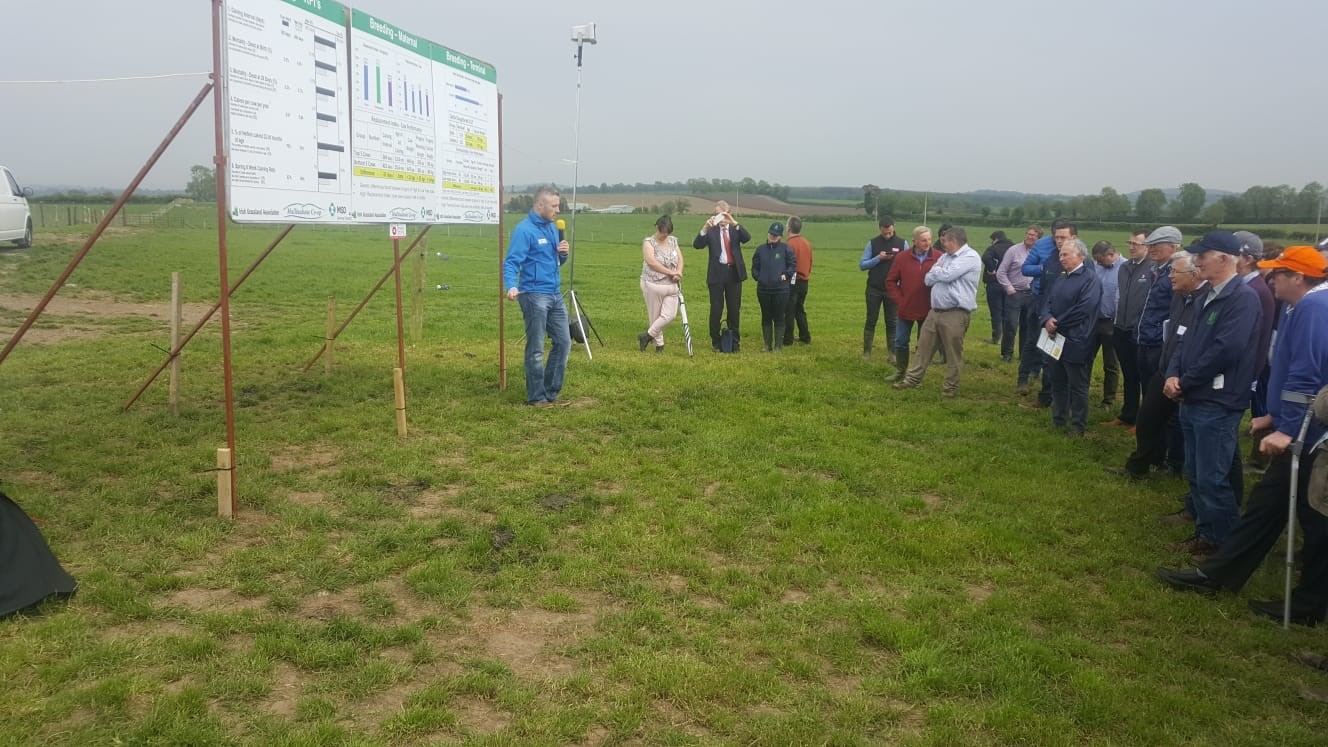The Irish Grassland Association held its annual beef conference on Thursday 24th May. The conference was held in the Clanard Court Hotel, Athy, Co. Kildare and consisted of a morning session in the hotel with presentations from 3 speakers, followed by an on-farm session covering areas including grass management, breeding and health. The event was attended by approx. 150 farmers and industry people.
Morning Session – Clanard Court Hotel
- Gerard Dineen – Suckler beef farmer, Co. Cork
Title of presentation: “Maximising grass growth on my farm”
Ger Dineen is well known to most Irish suckler farmers through his participation in the BETTER farm beef programme. He runs a 50 cow suckler herd in Cill na Martra, just outside of Macroom, Co. Cork. Ger operates a spring calving system, breeding all of his own replacements and selling surplus maiden heifers to other suckler farmers. All males are taken through to slaughter as U16 month bulls. Ger has one of the highest Replacement Index suckler herds in the country and his breeding strategy is based around 100% AI usage.
Ger won the beef grassland farmer of the year in 2017, with his farm growing an average of 14t tonnes DM per hectare. At the start of the BETTER farm programme grass growth was only 50% of this at 7 tonnes per hectare. Ger says that doubling his grass growth since 2012 has virtually doubled his farm size. He can now carry a much higher number of animals on the same amount of land.
- Donagh Berry – Statistical Geneticist, Teagasc
Title of presentation: “Breeding the best with the best will always give you the best – right?”
“Wrong” was the emphatic answer to this question! While mating two animals, both of a high genetic merit for a particular trait, increases the chances of producing an offspring of a high genetic merit on that trait, it does not guarantee it. There can be huge variability in the genetic makeup, even in full siblings. When asked the question ‘What can farmers do to make breeding indexes more reliable and remove some of the risks associated with breeding’, Donagh’s answer was simple:
- Genotype your animals
- Record lots of accurate data e.g. weights, docility scores, etc.
- Spread your risk by using teams of bulls i.e. use more AI. Not just any AI bulls though, but genetically elite AI bulls.
For more information on this presentation click here.
- Dr. Patrick Wall – Professor of Public Health, University College Dublin
Title of presentation: “Connecting with the final consumer is essential for sustainability”
Patrick Wall gave an excellent presentation on the importance of consumer awareness around food production. In addressing the farmers present, he mentioned how often times farmers see themselves as cattle producers, but they should in fact view themselves as food producers. Patrick spoke of how the Irish beef sector is in a very good position to address consumer concerns around sustainability, animal welfare, etc.
Afternoon Session – Farm of Thomas O’Connor, Moone, Athy, Co. Kildare
- Fiona Doolan & Christy Watson, B&T Drystock Advisors, Teagasc Naas
The first stop on the farm was to discuss the physical performance of the farm and the grassland management. Just like Ger Dineen’s earlier presentation, the key ingredients to good grassland management were good soil nutrition and good paddock infrastructure.
- Pat Donnellan & Chris Daly, ICBF
The second stop was a discussion on the breeding performance of the herd. The herd’s calving performance is exceptional, ranking in the top 10% nationally across a number of key performance indicators. The breeding policy on the O’Connor farm is based around 100% use of Terminal stock bulls with all progeny taken to slaughter. Replacement females are purchased in. When asked how he sources his replacements, Thomas said that he tries to source them from herds that he knows. He uses visual assessment to check for docility and functionality as well as the Euro-Star figures. Thomas felt that, given the information now available to farmers, buying breeding stock based solely on visual appearance is foolish, saying that Euro-Star figures should be taken into account. Thomas also noted that there was a gap in the market for specialist farmers to breed high genetic merit replacement females and supply them to herds, like his own, focused on Terminal genetics. To see the O’Connor herd’s breeding performance, click here.

- Bosco Cowley, MSD Animal Health
The final stop on the farm tour focused on herd health. Bosco Cowley went through the main issues around herd health on suckler farms, namely scour, pneumonia and IBR. The O’Connor’s buy in approx. 100 heifers and bulls each year to finish alongside the homebred progeny and Bosco noted that this was a significant threat to the herd’s biosecurity. As buying in stock is a reality on many Irish farms, he advised vigilance, screening and vaccination where required, as the best methods to control disease in these herds.
Feedback from those in attendance on the day was excellent with many noting the quality of the speakers and the information presented. For more information on the Irish Grassland Association visit its website on www.irishgrassland.com
